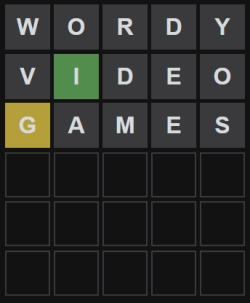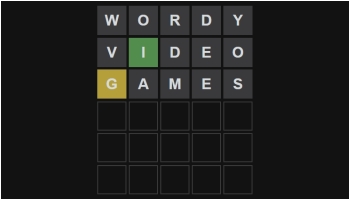 Every so often, a game comes along with a certain something that just completely captures the public’s fascination. It happened in 2006 with Wii Sports and its introduction of motion controls. It happened in 2007-2008 with Guitar Hero and Rock Band, a pair of games that seeded plastic instruments in living rooms across the world like some kind of Johnny B. Rockstar. It happened in 2016 with Pokemon Go, a game that encouraged players to go outside and explore the real world.
Every so often, a game comes along with a certain something that just completely captures the public’s fascination. It happened in 2006 with Wii Sports and its introduction of motion controls. It happened in 2007-2008 with Guitar Hero and Rock Band, a pair of games that seeded plastic instruments in living rooms across the world like some kind of Johnny B. Rockstar. It happened in 2016 with Pokemon Go, a game that encouraged players to go outside and explore the real world.
And for the last few months, it’s been happening with Wordle.
From our vantage point in February 2022, it’s clear to see why Wordle became as popular as it did. It’s a word guessing game, and for a few minutes at a time, it feels like the perfect distraction from everything else going on around you. Using rules popularized by Mastermind, a tabletop game from the 1970s; and Lingo, a game show that first aired in the 1980s; Wordle gives players six chances to figure out a hidden five-letter word.
Like those earlier games, Wordle returns a series of cryptic clues by flipping over the letters after each guess. Letters highlighted in green are in the target word and in the correct spot. Letters highlighted in yellow are in the target word but in the wrong spot. And letters highlighted in gray aren’t in the target word in any spot. While it might operate the same way as those games, what really makes Wordle special is that there’s only one puzzle a day and everyone in the world is trying to guess the same random word.
But how did it happen? Without the big marketing push of those other viral games, it’s sometimes felt like Wordle just appeared out of thin air. Thankfully, we can track the game’s backstory through a series of tweets that reveal exactly how it became such an obsession for thousands of people.
Developer Josh Wardle created Wordle as a gift for his partner, and uploaded the first version of the browser-based game on June 20. It quietly spread among their friends and family for several months before Wardle made it publicly available in October. A few weeks later, Wordle made its first appearance on Twitter courtesy of @waxy, a repository of “hot links and cool takes” from Andy Baio, on November 16:
Wordle: new daily word game from Josh Wardle, the creator of r/button and r/place at Reddit https://t.co/gLXPd9DgSM
— Waxy.org (@waxy) November 16, 2021
According to a New York Times profile of Wardle, the game had about 90 players at this point (and was partially inspired by Wardle’s appreciation for the New York Times Crossword). That would quickly change thanks to the Daily Wordle Club.
@dritchie, a web developer from New Zealand, shared a link to Wordle with his friends on November 24 and kicked off a Kiwi craze for the game:
Have you been playing Wordle? Like Mastermind (the board game) but for 5-letter words. I nailed today's in 3 attempts. https://t.co/IJQtHlSEkY
— David Ritchie (@dritchie) November 24, 2021
One of those friends, a writer and artist that goes by @faiako, created the #DailyWordleClub hashtag for the group on December 2:
Welcome to #dailywordleclub ??
— ??? Ms Fish (@faiako) December 2, 2021
Wordle was picking up steam at this point, but it needed one last push to achieve the level of viral notoriety that something like Animal Crossing: New Horizons did in 2020. Enter the grid.
Wordle players have been filling their social media feeds with a sea of green-and-yellow grids for the past two months, but @irihapeta (another New Zealander) was the first person to share her results using the squares on December 2:
#dailyWordleClub
Game 1
???⬛⬛
???⬛?
???⬛?
?????— Elizabeth S ? ?? (@irihapeta) December 2, 2021
The squares are an ingenious tactic to help spread the popularity of Wordle. They preserve the mystery of the day’s word while at the same time giving other players a roadmap to decipher how it was solved. And they’re intriguing enough to encourage non-players to ask “What’s Wordle?”
Wardle himself (@powerlanguish on Twitter) was intrigued, and he implemented the grid in Wordle through the addition of a Share Button on December 16:
Added a share button to Wordle that generates a spoiler-free emoji grid for you. Shoutout to @irihapeta for inventing such a cool way to share your results each day.
?
⬛⬛⬛⬛⬛
?⬛??⬛
?????Wordle 180 3/6
Try it out: https://t.co/pZTmeT1p7E
— Josh Wardle (@powerlanguish) December 16, 2021
@Gameonysus, the nom de Twitter of game journalist Janet Garcia, was the first person to share her Wordle results using the button (actually a few hours before the official announcement):
⬛⬛?⬛⬛
⬛⬛?⬛⬛
⬛⬛??⬛
⬛⬛???
?????
?????Wordle 180 6/6 #dailywordle
— Janet Garcia (@Gameonysus) December 16, 2021
Wordle‘s audience grew exponentially after those green-and-yellow boxes took over social media. Predictably, both knockoffs and loving tributes followed, but Wordle also had a huge effect on another game… Steven Cravotta’s Wordle!
Cravotta created his (completely unrelated) word game more than five years ago, and while it was moderately popular on Apple’s App Store after its release, the developer soon moved on to other projects. But without an official mobile app for Wardle’s Wordle, interested players found Cravotta’s game instead, and most seem to enjoy it.
While it would have been easy for @StevenCravotta to enjoy his good fortune, he decided to share his windfall with a literacy charity in Oakland on January 12:
Here’s how a mobile game I built 5 years ago suddenly got blown up by The New York Times, Wall Street Journal, and Jimmy Fallon.
?????? pic.twitter.com/aun7YM80p4
— Steven (@StevenCravotta) January 12, 2022
But there’s one last piece to this story. On January 31, Wardle sold Wordle to The New York Times for a dollar amount “in the low seven figures.” Growing far beyond its initial audience of two, the game now has millions of daily players:
An update on Wordle pic.twitter.com/TmHd0AIRLX
— Josh Wardle (@powerlanguish) January 31, 2022
The New York Times said that Wordle “would initially remain free to new and existing players,” but its future is now as mysterious as those green-and-yellow squares.
UPDATE (11/25/22): I think I need to add one more tweet to this history lesson. As you may have noticed with yesterday’s word selection, The New York Times has thrown out the original random word list for Wordle. A dedicated Wordle Editor has been assigned to the game, and going forward, they will choose which words are selected each day. The announcement of this changeover was made on November 8, and it was made to keep the game “fun, accessible, lively and varied” while also opening up the opportunity to use themed words like yesterday’s Thanksgiving-inspired selection of FEAST:
Starting Nov. 7, Wordle will have a dedicated editor. Answers will be drawn from the same basic dictionary of words, with some editorial adjustments to ensure that the game stays focused on vocabulary that’s fun, accessible, lively and varied. https://t.co/daqKymAMNR
— The New York Times (@nytimes) November 8, 2022
Wordle remains the same, but a small part of me is going to miss the randomness of the original game.

